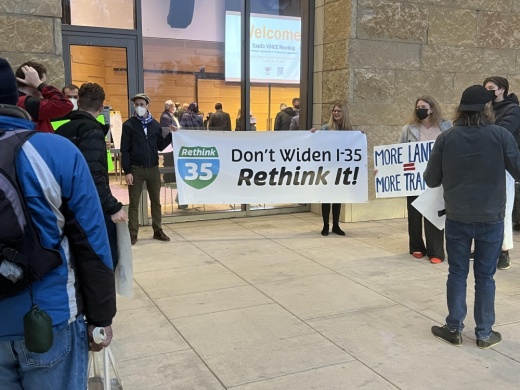Austin area residents expressed their opinions and concerns about the Texas Department of Transportation’s $4.9 billion I-35 Capital Express Central project that is expected to improve the city’s traffic flow through downtown.
The feedback from the community came out of a CapEx Volunteer Opportunity in Community Engagement meeting that TxDOT and the city of Austin hosted Jan. 25.
TxDOT’s proposal is to tear down the upper decks on I-35 through Central Austin, lower the lanes and add two high occupancy vehicle, or HOV, lanes in both directions. The project spans 8 miles between Hwy. 290 East to SH 71/Ben White Boulevard. The goal is to reduce congestion, improve safety and make it easier to travel east to west.
Alongside TxDOT, the city and the Downtown Austin Alliance—an advocacy organization that plans decisions in an effort to increase the area’s economic prosperity—are working on another opportunity that incorporates a cap and stitch design plan to better connect east and west Downtown Austin. A cap is a large deck over a lowered section of a highway that runs north to south. A stitch is a widened bridge on either side of a cross street over a lower highway, which could allow for widened sidewalks, bike lanes and seating areas.
“We’re doing as much as we can to accommodate what the community wants to see, but also developing the major interstate and keeping transportation open for travelers that are not local,” said Susan Fraser, TxDOT Austin District program manager.
Members of Rethink35 think otherwise about the CapEx Central project and would like to change the area into a boulevard instead of widening the highway. The Rethink35 organization held a protest outside the Jan. 25 VOICE meeting to convince attendees to “rethink” widening lanes on I-35.
“[TxDOT is] doing some community improvements to make it look nicer, but they’re doing nothing to minimize the footprint of the project or the damage it’s going to do to the amount of traffic and pedestrian safety,” Rethink35 member Sean Haney said.
Community Impact Newspaper previously reported that the addition of more lanes on the highway would induce demand, which would increase the amount of vehicles on the road. Studies from Rocky Mountain Institute’s State Highway Induced Frequence of Travel calculator have shown that within 10 years, a 10% increase in roadway capacity would lead to a 6% to 10% increase in vehicle miles traveled.
Haney, along with the Rethink35 organization, believes TxDOT should divert thru traffic outside of town and local traffic should stick to a boulevard. According to Fraser, a majority of the traffic is local, so TxDOT is working to provide solutions for local commuters.
There has been pushback from the public about the project’s failure to consider the needs of nearby communities or the highway’s history as a socioeconomic barrier between East Austin and Downtown Austin.
“Instead of healing the scar that was caused by running I-35 separating the communities decades ago, they’re widening the wound and making it even worse, and preventing more reunification in the future,” Haney said.
Although some Austin residents are skeptical about the I-35 Capital Express Central project, there are a lot of people hopeful for Austin’s future.
“Putting a freeway in the middle of downtown probably wasn’t the best choice anyway, and we have a chance to fix it. So staying involved and being thoughtful in how we interact, and thinking about what we can be doing, those are all great ways to get to a future we want,” Austin resident Felicity Maxwell said.
TxDOT and the city of Austin are continuing to work on incorporating the public’s ideas and thoughts, host pop-up meetings in different communities and proceed with VOICE meetings. There is no specific time period on community feedback. TxDOT is expecting to begin construction on I-35 in 2025. Visit www.my35capex.com to send feedback.






